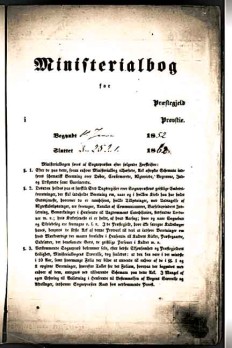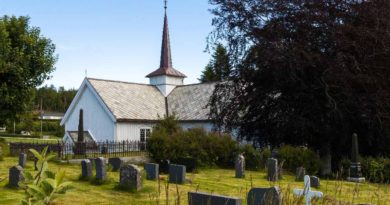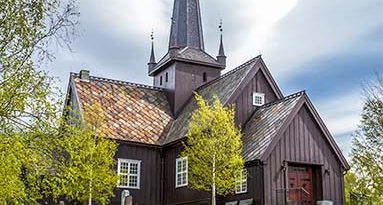The Norwegian Church books
The most important source genealogists use, are the church books. These records usually satisfy the demands of a trustworthy source. They are written by a person who was present at the event (the minister) and they were recorded at, or very close to the time of the event.
In this article I want to introduce you to the Norwegian church records and help you get started with this source. In Norwegian these church records are referred to as “Kirkebøker” or ”Ministerialbøker”. They were handwritten journals/books. I will go on by referring to them as church books.
The earliest surviving church books in Norway is from 1623 (Carlsen 2007:8). The first church books in Norway were written as “private projects” by some ministers. Through different laws and regulations (some regional, other national) more and more parishes started to keep church books. Unfortunately, many of the earliest books are lost.
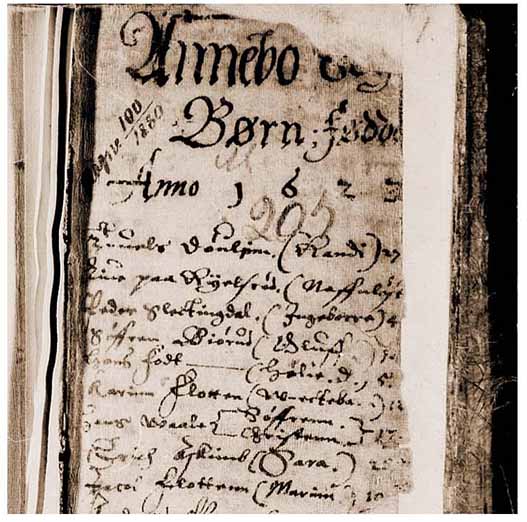
The beginning – Pre 1812
Before 1668 the ministers who kept records, wrote whatever they wanted(Juhasz 1978:88).
1668 – The ministers in Bergen stift (Bjørgvin diocese) were required to record baptisms and weddings (Bjerkås 1997:46) .
1685 The new church ritual in Denmark/Norway stated that the ministers were to record (Juhasz 1978:89):
Baptism:
- The name of the child
- The name of the parents
- The name of the witnesses
- In connection with baptism they recorded whether the child was “ekte” or “uekte” meaning if it was born in, or out of wedlock. Sometime the children born out-of-wedlock were recorded in a separate section of the church book.
Reading of banns/Engagement/Weddings:
- Name of the bride and groom
- Name of the witnesses/sponsors
Many times you will find the reading of banns or the engagement as the main record and then the wedding date was added as a small note when this took place.
Burials
In addition, they also recorded:
- Publice absolverede – This was a situation where one or more subjects were confessing and given absolution for a committed sin,that took place in the church in the presence of the whole congregation (Lokalhistoriewiki 2015). Read separate article here.
- Introducerede – This was a ritual that introduced a woman back into the congregation after having given birth. Very often the name of the woman was not recorded, but instead “Hans Hanson’s woman”. From 1750 this ritual was no longer required, but the tradition was in some places kept alive to about 1900 (Stoa/Sandberg 2015:93).
1687 The instructions in the Church ritual from 1685 were included in the Norwegian Law (Carlsen 2007:8)
Even though these laws and regulations were put in place, the ministers were not given detailed instructions as to how the records should be written. This means that the earliest church books are very varied in layout (Bjerkås 1997:47).
The layout can be divided into two main categories:
- All the clerical actions are listed chronologically
- The book is divided in different parts for the different clerical actions.
The layout differs a lot in the books. Some are kept very neat with beautiful handwriting and lot of space between the different records. Other might be cluttered, poorly written and every square millimeter of the page is used. These books can be very hard to read and the information you search might appear any place on the page.
When names were mentioned it was usually only the man’s name; “Baptized Hans Hansson’s child” . The name of the child might not be recorded. The birth and death date might not be recorded, only the date of the baptism and the funeral(Thorvaldsen 1996:90). In the second part of the 1700’s they started to record the actual birth and death dates. When it came to burials it was initially common to record the deceased’s age. Later they started to record the actual birth date/year. As the years went by, the records got better and more information was recorded (Bjerkås 1997:47).
One challenge in reading the oldest church records is the use of Gothic letters. This was a script used throughout Western Europe from approximately 1150 to well into the 17th century. The only way to negotiate this obstacle is to learn the script, at least the most used letters. Without this knowledge you can still recognize the names. You will see that the same name might be written differently through time. To familiarize you with Norwegian names, I suggest you read through my article on this topic.
In the oldest books the dates were recorded according to the liturgical calendar. As we have many movable feast-days you should go to the “Movable feast day calendar” and look for the year in question. It is important to remember that the year started the first Sunday in advent. This means that a person who is reported to be born in 1805, might be born in December 1804 (Carlsen 2007:9).
There are also some Latin words used in the church records. I have tried to collect them in my Norwegian genealogy dictionary.
When looking for baptisms you should be aware that in many books the minister has underlined the name of the child.
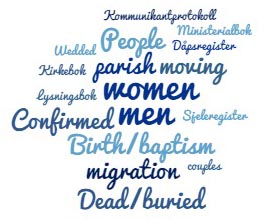
The revision of 1812
Through a rescript in 1812 it was ordered that the church records was to be kept in preprinted books. These books had the following forms. These forms are easily observable when looking at the churchrecords, but are mentioned by a number of authors such as Bjerkås (1997:53) and Thorvaldsen (1996:83).
- Birth/baptism men
- Birth/baptism women
- Confirmed men
- Confirmed women
- Wedded couples
- Dead/buried men
- Dead/buried women
- People moving out of the parish (migration)
- People moving into the parish (migration)
In addition to this, there is a “jevnføringsliste”. This is a list, usually kept in the back of the books, that cross-reference the different actions/rituals the person takes part in, starting with the birth, confirmation etc. This is often poorly kept (Bjerkås 1997:53)
One important thing about the 1812 revision was that the “klokker” was ordered to keep a copy of the church book. It should not “be kept over night under the same roof” (Carlsen 2007:8)
The “klokker” is a lay person that assists the minister during the church service. He is normally a person from sub-parish.
If available, you should have a look in both the “Ministerialbok” and the “Klokkerbok”. Often the minister travelled around in a big parish and left his copy of the church book at the rectory. He had to resort to lose leafs to take notes of his action. Later he would copy these notes into the church book. The “Klokker” normally recorded the information directly into his book. If there is divergence between the two copies I usually consider the “klokkerbok” as the most reliable. The “klokker” lived in the local community (sub-parish) and often knew the people in the congregation better than the minister.
It took some time before the parishes started to use the preprinted book. Some parishes kept on using the books with blank pages and drew in the forms based on the 1812 revision (Juhasz 1978:92) .
The 1820 revision
The clerical actions were to be recorded, according to a template, in forms that the minister drew up on blank pages. This may cause the clerical actions to be “chopped” up and appear in several smaller sections throughout the book. There was, however, many parishes that continued to use preprinted church books.
In this revision the “klokker” was no longer required to keep a copy of the church book. Most parishes did however continue to record the copies in the “klokkerbok” (Stoa/Sandberg 2015:104).
The information asked for in the 1820 revision were much more detailed than before. The new forms asked for additional information, in-depth discussed by Bjerkås (1997:54):
- Confirmand’s birthplace
- Bride and groom’s birthplace
- Name of the fathers of the wedded couple
- Stillborn were listed
- Cause of death if the person died from a contagious decease pr by an accident.
- All the children were to be recorded in the migration lists.
Two new sections were added to the church records:
- Name and date of (smallpox) vaccination
- The minister’s diary (chronological list of every clerical action he performed)
The changes in the 1820 revision was not fully implemented until about 1830. As the price of printing went down most parishes were back to using preprinted books by 1850 (Juhasz 1978:95).
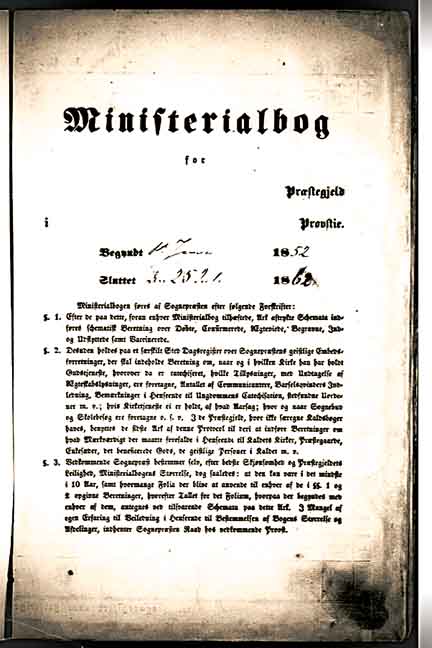
The 1877 revision
In an Order of council July 13, 1877 there was another revision to the forms in the church book (Bjerkås 1997:54).
The new information added was:
- The birth year of the parents in records about baptism.
- In the wedding records the year and place of confirmation where to be recorded if one, or both of the couple was confirmed in a sub-parish different from the one they were getting married in.
- Forms to record people who left or entered the Lutheran State Church (Statskirken)
The “Law about dissenters” put in place July 16, 1845 gave people the legal right to leave the Lutheran State Church. Before 1877 these actions were recorded in hand drawn lists, often in the back of the church books (Bjerkås 1997:55).
Even though a person left the Lutheran State Church the minister was supposed to record information about birth, weddings and death about this person (Thorvaldsen 1996:87).
From 1877 it was also required to keep separate church books for every localparish (Digitalarkivet).
Separate registers
As the population grew, especially in the towns, some of the clerical actions were recorded in separate books
- Lysningsprotokoll – According to law the intention of marriage had to be announced three separate Sundays from the pulpit of the church before the wedding could take place (Lokalhistoriewiki 2016).
- Forlovererklæringer – Signed statements by the sponsors of a couple about to get married.
These may yield detailed and interesting information about the bride and groom.
- Kommunikantprotokoller – Listing of parishioners taking part in communion. Through various laws and regulations, the members of the congregation were required to take part in communion at least once a year. This practice changed over the years. The requirement was abandoned in the 1800’s but some parishes kept these records well into the 1900’s (Stoa/Sandberg 2015:104).
- Dåpsbok – Separate listing of baptisms in the parish. Found alongside the church book
- Fødselsregister – Separate listing of births in the parish from about 1915. This is not a listing of clerical actions per see, but it was kept by the minister and are usually found alongside the church books. The births listed here should also be recorded in the church book (Stoa/Sandberg 2015:91).
- Sjeleregister – listing of all the people in the parish (Stoa/Sandberg 2015:105)
Some things to watch out for when working with church books
Thorvaldsen (1996) gives an interesting in-depth discussion about possible errors in the church-books.
I have already touched upon this above. One important improvement in quality in the church books, is the inclusion of the women in the church records.
Ministers, like anyone else, made mistakes and there are several occasions where you will find obvious errors in the church books. Sometimes this can be cross-checked by using the klokkerbok (Church book copy) or information from censuses.
In some cases the name of the father of an illigitimate child may be wrong. This can be difficult to pick up on and correct. The church records may be vague about the father’s name e.g. “Jon, visiting sailor” (Thorvaldsen1996:90).
People lost at sea was not always recorded in the church records when there was no body to bury.
Due to various reasons people may have attended church in a different parish than the one they lived in. An “out of parish” baptism was supposed to be reported to the minister in the correct parish, but this was not always done (Thorvaldsen 1996:91).
When it comes to causes of death in the church records we must remember that they did not have the diagnostic tools we have today. Also autopsies were very few and far between. This means that many recorded causes of death are, at best, vague. Have a look at my list of death causes found in Norwegian church records.
In many cases where the subject’s age is recorded, this is not always accurate. Also in cases where the subject’s birth-year is recorded it may be off. This may occur most often when a wedding, a confirmation or a funeral took place in a different parish from where the subjects were born.
The part of the church records that were poorest kept is the migration lists (Bjerkås 1997:53). People moving (with the intention of taking up residence) in, or out of the parish, were supposed to notify the minister and get a certificate. This was a simple form of ID papers and often also a certificate of good conduct. Thorvaldsen gives an in-depth discussion about the problems with migration lists.
Many left without getting a certificate. If they had no certificate to show, there was no reason to contact the minister in the new parish. Sometimes they requested the certificate many years after the actual move (perhaps to get married). This means we need to be cautious when using the migration lists. The fact that a person is not listed, does not necessarily mean he did not move. Also a move might not have taken place at the time it is registered.
Clerical actions taking place among dissenters were not always reported to the Lutheran minister as it was supposed to be. This means that, unless the denomination in question kept their own records, it can be hard to trace dissenters in church records. (Only a few records from churches outside the Lutheran State Church exist (Bjerkås 1997:56).
You might want to continue to the article about Gothic writing where I invite you to join my quest to get better at reading the old records.
Be sure to check out the “Downloads” section as I am publishing what I have called “Cheat sheets” to the Norwegian chirch books.
Sources:
Gunnar Thorvaldsen, Håndbok i registrering av historiske data (Oslo: Aschehoug 1996)
Lajos Juhasz, “Kirkebøkene i Norge” Norsk slektshistorisk tidskrift XXVI (1978):81-99
Nils Johan Stoa and Lars-Jørgen Sandberg, Våre røtter, slektsgransking som hobby (Oslo: Cappelen Damm 2015)
Nina Hveem Carlsen, “Prestens bok til åndelig og verdslig bruk,” Arkivmagasinet 1 (2007): 8-9
Ola Bjerkås, Preste- og prostearkiver. En brukerveiledning. Riksantikvarens skriftserie 4 (Oslo: Riksarkivaren, 1997)
Lokalhistoriewiki “Offentlig skrifte” accessed March 15. 2016
https://lokalhistoriewiki.no/index.php/Offentlig_skrifte License CC-BY-SA 3.0
Lokalhistoriewiki “Kirkebok” accessed March 15.2016
https://lokalhistoriewiki.no/index.php/Kirkebok License CC-BY-SA 3.0

